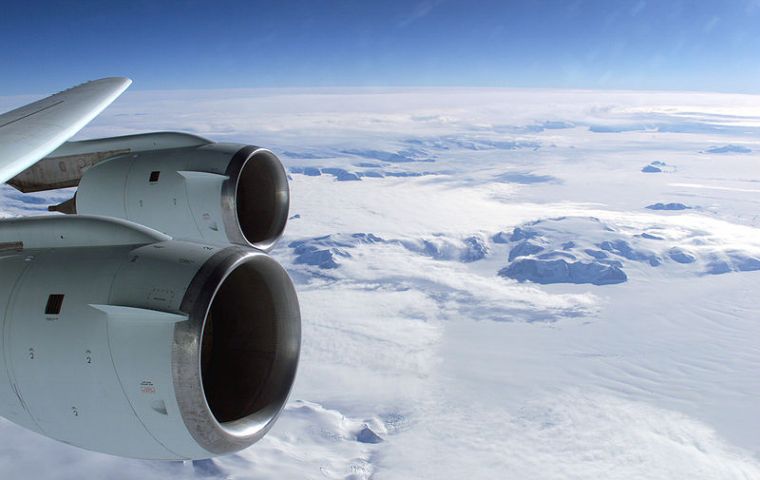MercoPress. South Atlantic News Agency
NASA Operation Ice Bridge takes off from Punta Arenas
 During six weeks NASA largest airborne lab will be flying over Antarctica
During six weeks NASA largest airborne lab will be flying over Antarctica Starting next Monday and operating from Punta Arenas in the extreme south of Chile NASA will fly its largest aircraft, --a DC-8, a 157-foot-long airborne laboratory-- to study changes in Antarctica’s sea ice, ice sheets and glaciers as part of its Operation Ice Bridge.
For six weeks, the Ice Bridge team will traverse the Southern Ocean for up to 17 flights over West Antarctica, the Antarctic Peninsula, and coastal areas where sea ice is prevalent. Each round-trip flight lasts about 11 hours, two-thirds of that time devoted to getting to and from Antarctica.
Operation Ice Bridge is a six-year campaign of annual flights to each of Earth's polar regions. The first flights in March and April carried researchers over Greenland and the Arctic Ocean. This coming Antarctic campaign, led by principal investigator Seelye Martin of the University of Washington, will begin the first sustained airborne research effort of its kind over the continent. Data collected by researchers will help scientists bridge the gap between NASA's Ice, Cloud and Land Elevation Satellite (ICESat) -- which is operating the last of its three lasers -- and ICESat-II, scheduled to launch in 2014.
The Ice Bridge flights will help scientists maintain the record of changes to sea ice and ice sheets that have been collected since 2003 by ICESat. The flights will lack the continent-wide coverage that can be achieved by satellite, so researchers carefully select key target locations. But the flights will also turn up new information not possible from orbit, such as the shape of the terrain below the ice.
“Space-based instruments like the ICESat lasers are the only way to find out where change is occurring in remote, continent-sized ice sheets like Antarctica,” said Tom Wagner, cryosphere program scientist at NASA Headquarters in Washington, D.C. “But aircraft missions like Ice Bridge allow us to follow up with more detailed studies and make other measurements critical to modelling sea level rise.”
ICESat launched in January 2003 and since then, its sole instrument -- a precise laser altimeter -- has helped scientists map ice sheet elevation, calculate sea ice thickness, and monitor how both have changed.
“With ICESat, we have seen significant changes, things we wouldn't otherwise know were taking place,” said Jay Zwally of NASA's Goddard Space Flight Center in Greenbelt, Md., and ICESat investigator on the mission. For example, shifts in surface elevation have previously revealed the draining and filling of lakes below Antarctica's ice.
Compared to the Arctic, where sea ice has long been on the decline, sea ice in Antarctica is growing in some coastal areas. Snow and ice have been accumulating in some land regions in the east. West Antarctica and the Peninsula, however, have seen more dramatic warming and rapid ice loss.
“We don't see the same sea ice changes in Antarctica that we see in the Arctic, and the reason is that the system is more complex,” said Thorsten Markus of NASA Goddard, the principal sea ice investigator for the mission. “But the fact that we don't see the same changes in Antarctica that we see in the Arctic doesn’t make it less important to study those changes. It's really important for us to understand the global climate system.”
With the DC-8 limited to just a few hours over Antarctica on each flight, mission planners have carefully selected targets of current and potential rapid change.
One such target is West Antarctica's Pine Island Glacier. “That glacier is one of the great unknowns because its bed -- where the glacier contacts rock -- is below sea level,” Martin said. “So if there's a surge or dramatic change, seawater could get under the glacier and we could be looking at very rapid change.”
Other proposed targets along the Amundsen coast include the Thwaites, Smith, and Kohler glaciers and the Getz Ice Shelf. Researchers also intend to study the myriad glaciers and ice shelves on the Peninsula, which has been undergoing dramatic changes.
“A remarkable change is happening on the Earth, truly one of the biggest changes in environmental conditions on Earth since the end of the ice age,” Wagner said. “It's not an easy thing to observe, let alone predict what might happen next. Studies like this one are keys”.




Top Comments
Disclaimer & comment rulesCommenting for this story is now closed.
If you have a Facebook account, become a fan and comment on our Facebook Page!